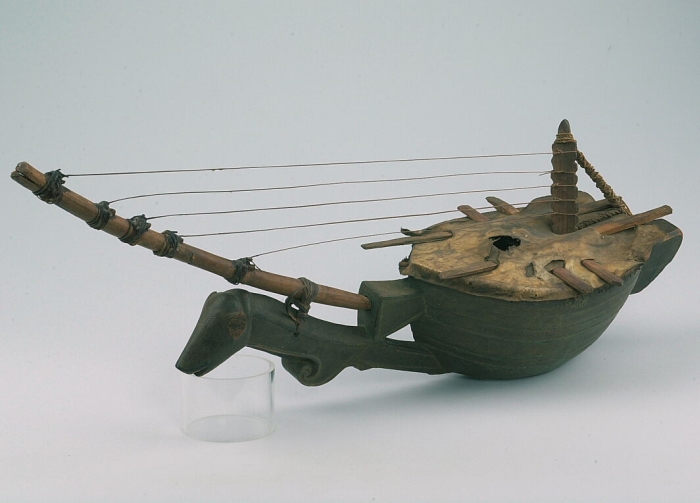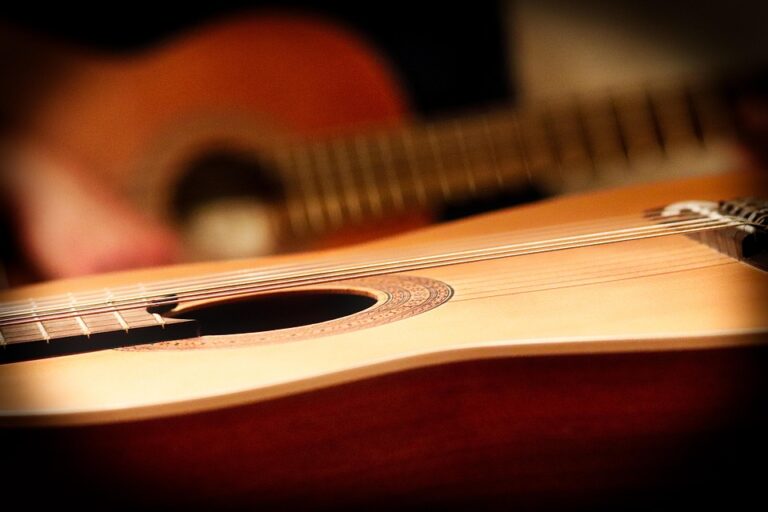The Musical Bow: A Sonic Experiment in Prehistory
The earliest string instruments may have been musical bows—essentially a flexible stick with a single string stretched taut across it. Archaeological and ethnographic evidence suggests that these instruments appeared over 10,000 years ago in Africa and parts of Eurasia. Some anthropologists theorize that the musical bow was inspired directly by hunting bows. Hunters discovered that the twang of a bowstring could produce a musical tone, prompting experimentation with different lengths, thicknesses, and tensions to produce varying pitches.
Early makers quickly noticed subtle differences: a longer string vibrated slower and produced a lower note, while a shorter or thinner string vibrated faster and produced higher tones. Some bows incorporated resonating gourds, essentially primitive resonator boxes that amplified sound. In some communities, the bow’s musical potential was linked to ritual, storytelling, and communication. Hunters could send coded signals over distances, exploiting the same principle later used in “talking drums.” In this sense, the musical bow was both a practical device and a sonic experiment, representing the first step in humanity’s systematic exploration of vibration, tension, and resonance. The cultural significance was profound: sound was not merely decorative, but an essential part of social life and survival.
The Lyre: A Sacred Instrument in Mesopotamia
By around 3500 BCE, the lyre emerged in Mesopotamia as a more complex and symbolic string instrument. These instruments were not just entertainment—they were sacred objects, often buried with kings, priests, and nobles, reflecting a belief that music could bridge the human and divine realms. The renowned Lyres of Ur, excavated in the 1920s, demonstrate remarkable craftsmanship: multiple gut strings, gold and lapis lazuli inlays, and intricately carved soundboxes.
The most extraordinary lyre, the “Bull’s Head Lyre,” incorporated an actual ox skull at its top, believed to imbue the instrument with divine power. Musicians played the lyre during funerary rites, weddings, and religious ceremonies, and the sound was thought to soothe gods or guide souls in the afterlife. From a technical perspective, the lyre required understanding of string tension, resonance, and vibration across multiple strings to produce consonant notes. The placement of strings and the construction of the soundbox created rich harmonic overtones, demonstrating an early mastery of acoustical design principles. The lyre thus functioned as a tool of spiritual communication, scientific experimentation, and artistic expression, showing that ancient societies deeply valued sound both culturally and technically.
Harps and Egyptian Tomb Mysteries
In ancient Egypt, harps dating back to 2500 BCE evolved into triangular shapes that varied in size and complexity. Archaeological finds indicate that some harps were buried in tombs alongside the deceased, accompanied by detailed instructions for playing. This suggests a sophisticated musical culture with a structured pedagogy. One particularly fascinating example comes from a harp in a noblewoman’s tomb: the strings were wrapped in different colored threads, which may have functioned as an early form of musical notation, allowing the music to be “recorded” for the afterlife.
Some surviving harps were so large they required multiple people to carry, indicating that size was both functional and symbolic. Large resonant bodies amplified sound for ceremonial purposes, while simultaneously demonstrating authority and wealth. Technical innovations included variations in string thickness, tension adjustments, and soundbox shape, all of which allowed for greater control of pitch and tone. Harps were tuned intuitively, often by ear, but careful observation ensured harmonic relationships between strings. These instruments illustrate how practical design, acoustic experimentation, and social symbolism converged in the earliest advanced string instruments.
Gut Strings: A Smelly but Ingenious Innovation
Early string makers discovered that animal intestines produced the most reliable strings. Gut strings required laborious preparation, including cleaning, stretching, drying, and sometimes boiling, producing a pungent odor. Despite this, gut provided elasticity, durability, and smooth vibration surfaces superior to plant fibers or sinew. These qualities allowed musicians to produce sustained tones with precise pitch control, and their elasticity enabled dynamic expression, which became essential for performance.
In medieval Europe, some musicians reportedly soaked gut strings in wine or saltwater to enhance resilience or slightly adjust pitch. While these methods may seem anecdotal today, they demonstrate a practical understanding of material properties, including elasticity, tension, and moisture effects. Gut strings also allowed experimentation with diameter, twist, and length, influencing tonal color and volume. The successful development of gut strings represented an early intersection of material science and acoustic engineering, showing that even the earliest instrument makers understood the importance of tuning, tension, and resonance in crafting a versatile instrument.
The Guqin: Music for the Mystics
In ancient China, the guqin, a long plucked zither, was associated with scholars, philosophers, and mystics. These instruments often had seven strings, each symbolically linked to virtues or cosmic elements. Legends suggest that Confucius played the guqin to calm storms or guide human behavior, emphasizing the profound philosophical and spiritual role of music. The guqin’s long, thin wooden body, paired with movable bridges and carefully calibrated string tension, allowed for subtle, meditative tones, producing expressive microtonal variations that could convey emotion and narrative.
From a technical perspective, the guqin introduced innovations such as movable frets and string height adjustment, enabling precise intonation across a wide tonal range. Its design emphasized sustain, harmonic overtones, and delicate timbre, contrasting with the more resonant, louder lyres and harps of the West. Guqin players developed intricate plucking techniques, glissandos, and harmonics to fully exploit the instrument’s acoustic potential. In essence, the guqin reflects an early blend of technical engineering, musical theory, and philosophical thought, illustrating how sound could be deliberately crafted to resonate with both mind and spirit.
The Mystery of the First Bowed Instruments
While many early instruments were plucked, some may have been bowed, creating continuous vibration. The Persian kamancheh and related instruments used a bow drawn across a string, producing sustained, haunting tones. Nomadic tribes in Central Asia reportedly discovered this technique by dragging horsehair over gut strings while telling stories around campfires.
Bowed instruments introduced new possibilities: long, sustained notes, subtle vibrato, and dynamic modulation. They allowed performers to create emotional depth in ways plucked instruments could not. This approach may have predated some polyphonic plucked instruments, revealing a cultural appreciation for expressive, continuous sound. From a technical standpoint, bowed strings required understanding friction, pressure, and string response, demonstrating early experimentation with the mechanics of sound production. This innovation expanded the expressive range of music and influenced later developments in violin-like instruments and orchestral string traditions.
Lyres and War: Instruments in Unexpected Places
In early societies, lyres were sometimes used alongside warfare. Ancient Assyrian reliefs depict soldiers carrying lyres and drums to coordinate movements, intimidate enemies, or boost morale. Music, in this context, was a tool of both psychological and physical influence.
A striking anecdote involves a king whose lyre was reportedly so resonant that its sound could make enemy shields vibrate. Whether literal or symbolic, this story demonstrates early recognition of resonant vibration as a tangible force, not merely an artistic phenomenon. Lyres used in battle required robust construction, tension stability, and acoustic projection, highlighting the functional versatility of early string instruments. In this sense, the first strings were not only musical tools but instruments of strategy, communication, and social influence.
Musical Innovation Through Experimentation
Across all cultures, the first string instruments emerged through careful observation, trial, and error. Makers discovered fundamental principles: thinner strings vibrate faster, producing higher pitches; longer strings vibrate more slowly, producing lower pitches; hollow resonators amplify sound; and curved or reinforced frames prevent breakage.
These discoveries were made without formal mathematics or physics, yet reflect a deep intuitive understanding of acoustics. Early musicians and craftsmen observed cause-and-effect relationships, experimented with materials like gut, silk, or wood, and optimized designs for both tonal quality and durability. Instruments like the musical bow, lyre, zither, and harp represent the intersection of artistry, engineering, and science, demonstrating humanity’s earliest sophisticated approach to sound production.
The Social and Spiritual Role of Early String Instruments
Beyond technical innovation, early string instruments played profound social and spiritual roles. In Mesopotamia, lyres accompanied religious ceremonies; in China, the guqin was used in philosophical contemplation; in Africa, musical bows served as storytelling and communication tools. Sound became a medium for transmitting culture, reinforcing social hierarchies, and engaging with the sacred.
These instruments also influenced early education and socialization. Children and apprentices learned not only performance skills but the acoustic principles underlying their instruments. Music thus became a form of experiential science, training generations in observation, experimentation, and refinement of technique. In this way, string instruments contributed to both cultural cohesion and the intellectual development of early societies, long before the formal study of acoustics existed.
Cross-Cultural Diffusion of String Instruments
As civilizations expanded and traded across regions, the knowledge of string instruments spread rapidly, adapting to local materials, rituals, and musical tastes. The lyres of Mesopotamia influenced harp construction in Egypt, while the guqin of China inspired zither-like instruments throughout East Asia. Nomadic tribes traveling the Silk Road carried bowed instruments and hybrid designs, facilitating cross-pollination of acoustic principles. This cultural diffusion encouraged experimentation with string materials—gut, silk, horsehair—and resonator types, leading to innovations in tonal range, sustain, and volume. In several cases, instruments traveled along trade routes in both literal and conceptual form, influencing not only musical styles but also performance techniques. For example, the adoption of movable bridges from Central Asian bowed instruments allowed for fine-tuning intervals, a concept later central to the development of European lutes and viols.
This period demonstrates that early string instrument innovation was not isolated, but rather a collaborative, multi-regional effort. Societies were learning from each other, borrowing ideas about resonator size, string tension, and harmonic relationships, and refining these concepts in localized contexts. In this way, instruments became vehicles for technological as well as cultural exchange, showing that music and mechanics co-evolved in tandem. The result was a gradual emergence of systematic approaches to tuning, tonal consistency, and ergonomic design long before formalized scientific methods existed.
Early Experiments in Tuning and Acoustic Resonance
Parallel to the cultural diffusion of instruments, early builders engaged in deliberate acoustic experimentation to improve sound quality and control. They discovered that subtle changes in string length, diameter, tension, and resonator shape dramatically affected pitch and timbre. Some civilizations experimented with graduated string diameters, creating scales that allowed more precise melodic expression. Others varied the curvature of soundboards or the placement of bridge points to enhance resonance and sustain.
Interestingly, some early makers noticed that certain resonator shapes amplified overtones, producing richer harmonic textures. The Egyptians, for example, adjusted soundbox depth and material density to enhance projection for large ceremonial halls, while Mesopotamians refined lyre dimensions to produce polyphonic chords with minimal dissonance. These practical experiments laid the groundwork for mathematical understanding of acoustics, even if builders did not articulate it in theoretical terms. Essentially, they were early acoustic engineers, using observation, measurement, and iterative refinement to transform simple strings into finely tuned instruments capable of both aesthetic and functional performance.




